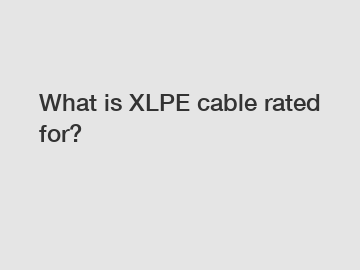What is XLPE Cable Rated For?
XLPE cable, also known as cross-linked polyethylene cable, is a widely used electrical cable known for its exceptional thermal and mechanical properties. But what is XLPE cable rated for? In this article, we will explore the various ratings and applications of XLPE cable, dive into its construction and unique features, and highlight its benefits and limitations. So let's jump right in!
1. Voltage Rating:

One of the significant aspects of XLPE cable is its voltage rating. XLPE cables can be rated for different voltages, ranging from low to high voltage applications. The most common voltage ratings include 600V, 1000V, and 35kV. These ratings determine the maximum voltage that the cable can safely handle without causing any insulation breakdown or failure.
2. Temperature Rating:
XLPE cables are specifically designed to withstand high temperatures. The temperature rating of XLPE cable varies depending on the application and environment. Typically, XLPE cables can handle temperatures ranging from -40°C to 90°C, making them suitable for a wide range of industries and operating conditions.
3. Current Carrying Capacity:
Another crucial aspect of XLPE cable rating is its current carrying capacity. This is the maximum amount of electrical current that the cable can safely carry without exceeding its temperature limits. The current carrying capacity of XLPE cable depends on factors such as conductor size, insulation thickness, and ambient temperature. It is essential to select the appropriate cable size based on the maximum current load requirements to ensure optimal and reliable performance.
4. Short-Circuit Rating:
The short-circuit rating of an XLPE cable is a measure of its ability to withstand the thermal and mechanical stresses resulting from a short-circuit fault. This rating determines the maximum fault current that the cable can safely endure without sustaining significant damage. A higher short-circuit rating implies better fault current withstand capability, ensuring the safety and integrity of the cable system.
5. Insulation and Construction:
XLPE cables are built with a unique cross-linked polyethylene insulation that offers excellent electrical and mechanical properties. The insulation material helps in maintaining a stable dielectric strength, enhancing the overall performance and longevity of the cable. The construction of XLPE cable usually consists of one or more copper or aluminum conductors, layered with the XLPE insulation, followed by a protective outer sheath. This construction provides robustness, flexibility, and protection against external factors such as moisture, chemicals, and mechanical stress.
6. Applications:
XLPE cables find extensive applications in various industries, including power transmission and distribution, industrial plants, underground installations, renewable energy systems, and more. Their ability to handle high voltage, temperature, and current loads make them suitable for both indoor and outdoor applications. The durability, reliability, and longevity of XLPE cables contribute to their popularity in critical infrastructure development projects worldwide.
7. Benefits and Limitations:
XLPE cables offer several benefits, such as improved electrical performance, reduced maintenance costs, and enhanced resistance to environmental factors, including UV radiation, water, and chemicals. They are also known for their superior thermal stability, allowing for higher system efficiency. However, it's important to note that XLPE cables have certain limitations, such as higher installation costs, limited flexibility compared to some other cable types, and sensitivity to certain installation conditions.
In conclusion, XLPE cable is rated for various factors, including voltage, temperature, current carrying capacity, and short-circuit fault withstand capability. These ratings determine the suitability of XLPE cables for different applications and environments. The exceptional insulation properties, robust construction, and wide-ranging voltage and temperature ratings make XLPE cables a popular choice across industries. Understanding the specific needs of the installation and selecting the appropriate XLPE cable can ensure optimal performance and reliability for electrical systems.
If you want to learn more, please visit our website SWA Low Voltage Power Cable, 16mm solar cable, 70mm 4 Core SWA Cable.



Comments
Please Join Us to post.
0